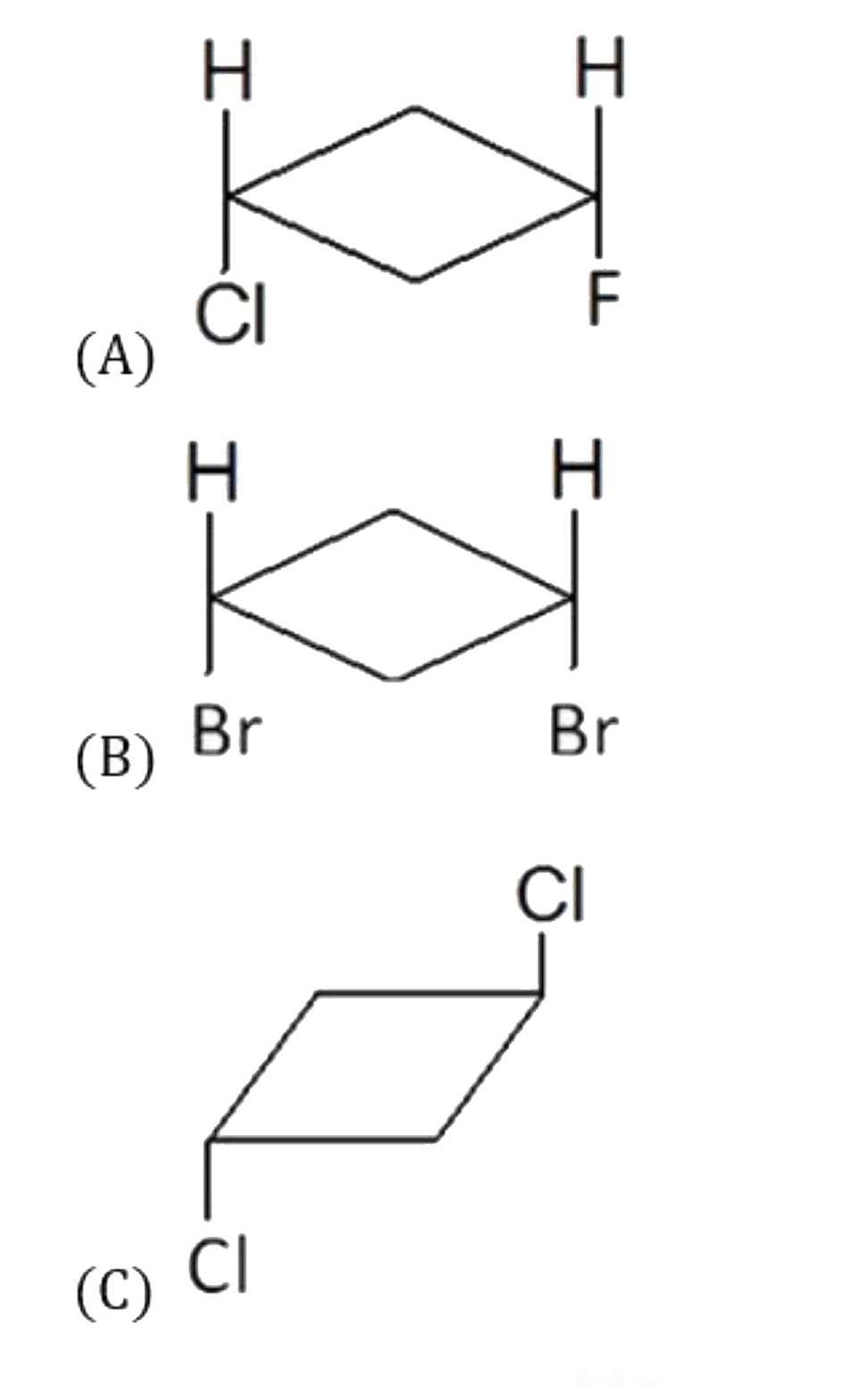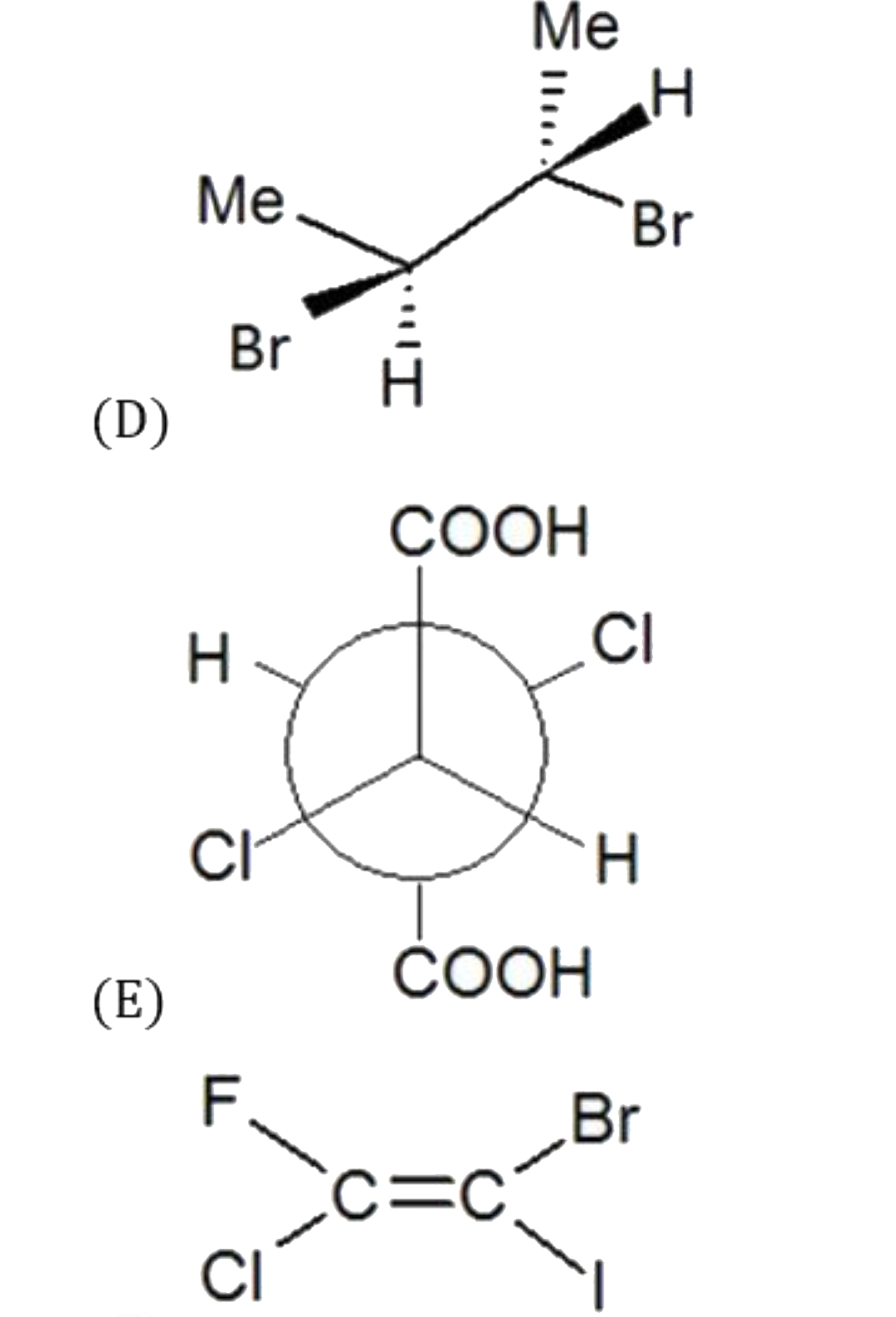Propane on dichlorinatin gives......isomers and out of them .....are optically active.
4,1
3,1
4,2
3,2
The correct Answer is:a
To solve the question regarding the dichlorination of propane, we will follow these steps:
Step 1: Understand the Structure of Propane
Propane (C₃H₈) is a straight-chain alkane with three carbon atoms. Its structure can be represented as:
HHH|||H−−C−−C−−C−−H|||HHH
Step 2: Perform Dichlorination
Dichlorination involves replacing two hydrogen atoms in propane with chlorine atoms. This can happen in several ways, leading to different isomers.
Step 3: Identify Possible Isomers
1. 1,1-Dichloropropane: Both chlorine atoms are attached to the first carbon.
- Structure:
ClCl||H−−C−−C−−C−−H||HH
2. 1,2-Dichloropropane: One chlorine atom on the first carbon and one on the second carbon.
- Structure:
ClH||H−−C−−C−−C−−H||HCl
3. 1,3-Dichloropropane: One chlorine atom on the first carbon and one on the third carbon.
- Structure:
ClH||H−−C−−C−−C−−H||HCl
4. 2,2-Dichloropropane: Both chlorine atoms are attached to the second carbon.
- Structure:
HCl||H−−C−−C−−C−−H||ClH
Step 4: Count the Total Isomers
From the above structures, we can see that there are a total of 4 isomers formed during the dichlorination of propane.
Step 5: Identify Optically Active Isomers
An optically active compound has a chiral center, which means it has a carbon atom attached to four different groups.
- 1,1-Dichloropropane: Not optically active (no chiral center).
- 1,2-Dichloropropane: Not optically active (no chiral center).
- 1,3-Dichloropropane: Not optically active (no chiral center).
- 2,2-Dichloropropane: Optically active (the second carbon is a chiral center).
Conclusion
Thus, the answer to the question is that propane on dichlorination gives 4 isomers, and out of them, 1 is optically active.
Final Answer
4 isomers and 1 optically active.
---
Propane (C₃H₈) is a straight-chain alkane with three carbon atoms. Its structure can be represented as:
HHH|||H−−C−−C−−C−−H|||HHH
Dichlorination involves replacing two hydrogen atoms in propane with chlorine atoms. This can happen in several ways, leading to different isomers.
1. 1,1-Dichloropropane: Both chlorine atoms are attached to the first carbon.
- Structure:
ClCl||H−−C−−C−−C−−H||HH
- Structure:
ClH||H−−C−−C−−C−−H||HCl
- Structure:
ClH||H−−C−−C−−C−−H||HCl
- Structure:
HCl||H−−C−−C−−C−−H||ClH
From the above structures, we can see that there are a total of 4 isomers formed during the dichlorination of propane.
An optically active compound has a chiral center, which means it has a carbon atom attached to four different groups.
- 1,2-Dichloropropane: Not optically active (no chiral center).
- 1,3-Dichloropropane: Not optically active (no chiral center).
- 2,2-Dichloropropane: Optically active (the second carbon is a chiral center).
Thus, the answer to the question is that propane on dichlorination gives 4 isomers, and out of them, 1 is optically active.
4 isomers and 1 optically active.
Topper's Solved these Questions
- AROMATIC COMPOUNDS AND ALKYL AND ARYL HALIDES BOOK - CENGAGE CHEMISTRY ENGLISHCHAPTER - AROMATIC COMPOUNDS AND ALKYL AND ARYL HALIDES EXERCISE - Exercises Assertion-Resoning Type
1 Videos
- AROMATIC COMPOUNDS AND ALKYL AND ARYL HALIDES BOOK - CENGAGE CHEMISTRY ENGLISHCHAPTER - AROMATIC COMPOUNDS AND ALKYL AND ARYL HALIDES EXERCISE - Exercises Assertion-Resoning
11 Videos
- AROMATIC COMPOUNDS AND ALKYL AND ARYL HALIDES BOOK - CENGAGE CHEMISTRY ENGLISHCHAPTER - AROMATIC COMPOUNDS AND ALKYL AND ARYL HALIDES EXERCISE - Exercises Single Correct Answer Type
28 Videos
- APPENDIX INORGANIC VOLUME 2BOOK - CENGAGE CHEMISTRY ENGLISHCHAPTER - APPENDIX INORGANIC VOLUME 2EXERCISE - Short Answer Type
179 Videos
- BIOMOLECULESBOOK - CENGAGE CHEMISTRY ENGLISHCHAPTER - BIOMOLECULESEXERCISE - Exercises Archives (Analytical And Descriptive)
8 Videos
Similar Questions
Knowledge Check
Which of the following are optically active?
A B
B CCH3−CH∣D−COOHD
CCH3−CH∣D−COOHD
Which of the following are optically active?
A B
B C
C D
D
An optically active compound
Arotates the plane of polarised lightBchanges the direction of polarised lightCdoes not allow plane polarised light to pass throughDnone of these.



